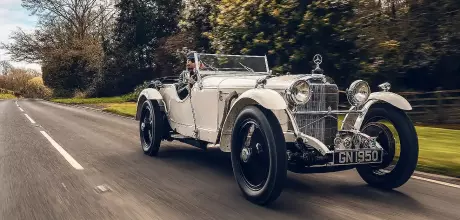1928 Mercedes-Benz 26/120/180 S-Type Sports Tourer driving the supercharged supercar of its day
This most Germanic of motor cars has a particularly British back story, as Mark Dixon finds out.
Photography Richard Pearce
WHITE CHARGER
When I was a youngster, I devoured the Jennings series of children’s books, about an enthusiastic but trouble-prone schoolboy called Jennings and his gawky, geeky sidekick Darbishire. Set at a boarding prep-school in a cosy ‘lost England’ world that was intensely nostalgic, the first book appeared in 1950 and the last one, amazingly, came out in 1994.

In one of the books, Jennings writes to various motor manufacturers in the hope they’ll send him some car brochures, carefully omitting his age so that they’ll assume he’s a potential customer. Unfortunately, one of the companies – I’ve always liked to think it might have been Alvis – takes the initiative and despatches a sales rep with a demonstrator to ‘Linbury Court’, the name of the school. With hilarious results.
Truth is often stranger than fiction, and Bill Boddy, the legendary editor of Motor Sport, recalled in 1975 how at age 14 he had a letter about supercharging published in a car magazine. It was, he admitted, very presumptuous, but it resulted in Lagonda and British Mercedes- Benz Ltd both inviting him for test drives. Of course, neither company realised his age, which hadn’t been printed in the magazine…
‘Acceleration is just as vigorous as you’d expect, like a glider being pulled into the air by its launch cable’
Full credit to them: neither Lagonda nor British Mercedes were fazed by the youthfulness of their would-be test driver when he turned up as arranged, and both treated him to high-speed passenger rides. He visited Mercedes first, and was taken out in a 36/220 S-Type exactly like the car pictured here. ‘Our objective was the Barnet bypass, along which these great cars were regularly tested and demonstrated. Here the blower was made to emit its shrill howl, the speed increased, the wintry wind tore round the windscreen and, eyes glued to the speedometer, I saw it register 99mph, before the driver lifted off,’ he remembered. ‘I returned home, a Mercedes convert for life!’
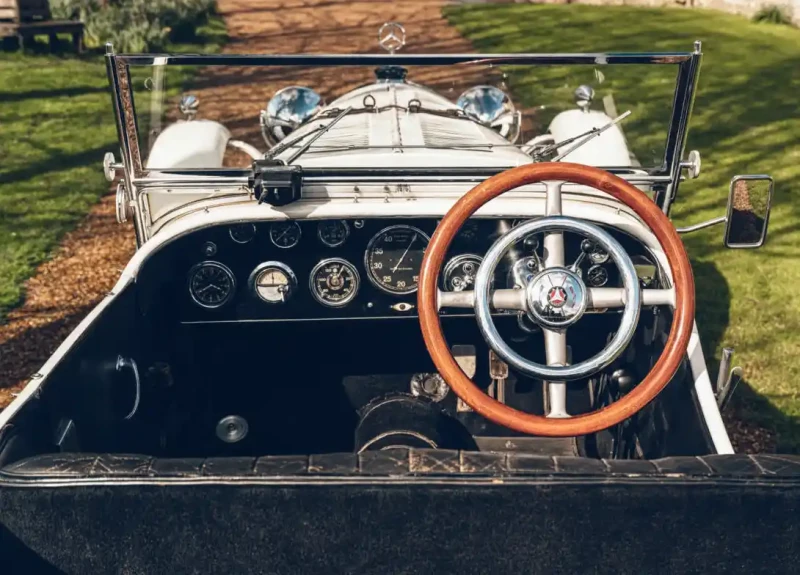
He was far from the only Brit to be seduced by the magnificence of German engineering during the 1920s, not long after the end of World War One. About the time that Boddy was having his joyride in the 36/220, Sir Cecil Harcourt-Smith, a British envoy to Cairo, ordered a very similar Mercedes-Benz S-Type Four Seater Tourer from the Sindelfingen factory. Chassis 35985 fitted with engine 72191 was delivered to British Mercedes Ltd London on 19 December 1928. Quite the Christmas present.
Mercedes already had more than a decade of experience with supercharging engines, experience ironically gained from a need to make German WW1 fighter aircraft fly higher to avoid flak from the ground. Forcing more fuel/air mixture into the engine restored the power lost by the thinner air present at high altitudes, and parent company Daimler’s engineers realised that it would also increase power output in a car engine at ground-level. So, from 1919, Daimler/Mercedes experimented with a whole range of supercharged cars, both for road use and for competition.
‘Realising that he had a great engine in search of a chassis, Porsche had instigated the creation of the S-Type’
Unfortunately, the cost of manufacture at a time when customers’ belts were tight meant that the smaller cars were never a great success. But there was a niche market for bigger, more luxurious supercharged Mercedes, and the lofty 630 model that preceded the S-Type proved successful in competition, despite having a relatively high chassis that compromised its handling.
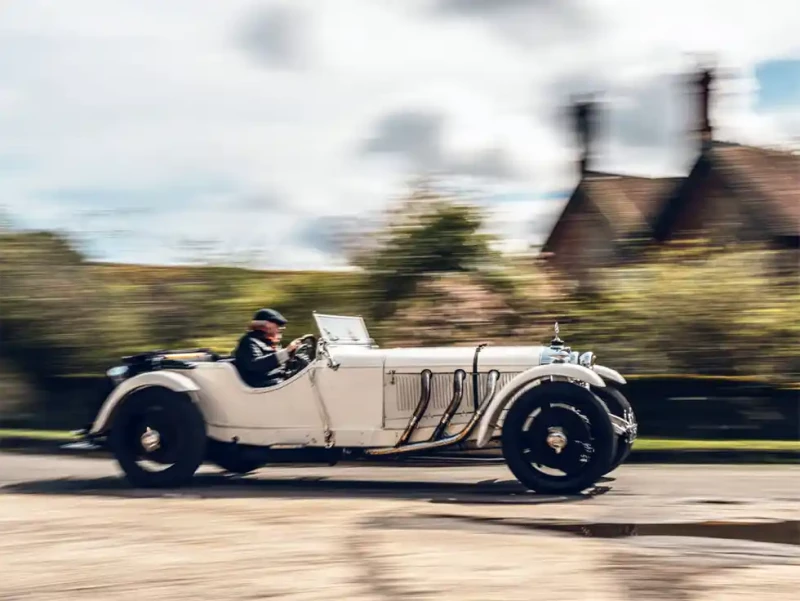
Heart of these super-Mercs was an engine designed by Mercedes’ chief engineer, Ferdinand Porsche – yes, that Porsche. He’d come on board mid-1923 and overseen design of a masterful new straight-six, with overhead camshaft, block made of Elektron and crankcase of aluminium – both to save weight – and a Roots-type supercharger that could be engaged by shoving the accelerator pedal down hard. The forerunner of what would become the S-Type was the 24/100/140 model of 1924, the three figures signifying fiscal horsepower rating, actual horsepower without blower engaged, and the supercharged horsepower. That’s a pretty stark indication of the difference that the supercharger made.
When Daimler merged with Benz in 1926, the 24/100/140 was renamed the 630 (or 630K if it was a short-chassis Kurz version). More significantly, however, the merger meant that Porsche found he had a rival in Benz’s own chief engineer, Hans Nibel. Following a clash with Mercedes-Benz’s managing director, Porsche would leave the company in 1929, to be replaced by Nibel.
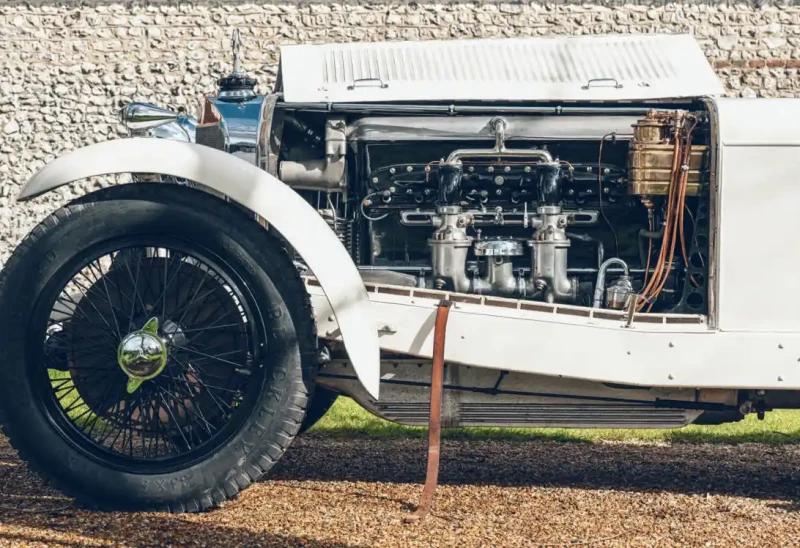
He’d made his mark, however. Realising that he had a great engine in search of a chassis, Porsche had instigated the creation of the S-Type. It featured a new, dropped chassis with the engine mounted lower and further back, and the rear springs suspended under the rear axle. The engine itself, which had been constantly evolved over the preceding years, was now of 6.8 litres capacity, had twin rather than single carburettors, a dual ignition system and many other refinements. A pair of the first racing versions of this car, then known as the 680S, debuted at the Nürburgring on 19 June 1927. Not surprisingly, Mercedes scored a 1-2 finish with them in the hands of Caracciola and Rosenberger, respectively. An older 630K, driven by privateer Von Mosch, was third.
The production version of the 680S was dubbed the 36/220, or S-Type, and was exhibited at the London motor show at Olympia with, according to Bill Boddy, a retail price of $2300 for a chassis bodied as an open tourer. A house in Greater London could have been bought in the low hundreds at the time.
By 1934, Harcourt-Smith’s S-Type had passed to a Cambridge student – yes, really – who campaigned it in stripped-down form at that year’s Inter-Varsity Trials. John Fitzroy, the ninth Duke of Graft on, was just 20 at the time and tragically he would die two years later, racing his Bugatt i in the Limerick Grand Prix.
The next recorded owner was another keen amateur racer, Robert Arbuthnot, who bought it in 1939 and sold it in 1946 to Edward L Mayer, a collector who was so fanatical about Mercedes that he owned around 100 examples during his lifetime. Sadly, the car lost its original wings in this period – it had been built with Mercedes’ usual very long, straight, sloping front wings – and was re-equipped with the cycle wings it still wears. It was one of Mayer’s favourites, and he kept it until 1960 when advancing age led him to sell it to another pioneering collector, Peter Hampton, founder of the well-known estate agents Hamptons.
Peter Hampton gave the 36/220 a comprehensive refresh that included a colour change from black to its current white, and some repanelling of the driver’s side bodywork aft of the bonnet. Originally, the Mercedes had a door here – it’s still with the car – but Hampton had this aperture filled in, probably because he also had the handbrake relocated to the outside and the central gearchange moved to the right of the driver’s seat. Both alterations were necessitated by war wounds he’d sustained to his left hand during the D-Day landings at Normandy in 1944.
It’s claimed that, early in Hampton’s ownership, his newly acquired Mercedes was immortalised by Matchbox Toys for its Models of Yesteryear series, and certainly it did release a 36/220 model in white with black seats in 1963, albeit with original-style long front wings. Including the S-Type in this most British range of toys introduced it to a whole new generation of car enthusiasts – how many Octane readers have one tucked away on a shelf or desktop?
This car’s most recent custodian has been the late Tom Scott, who bought it from a Brooks auction aft er the death of Peter Hampton in 1991. It formed part of a collection of Mercedes that is now, in turn, going to be offered for sale by Bonhams at the Festival of Speed, following Scott’s own passing. It’s the very car that, in 1975 while still owned by Hampton, Bill Boddy finally got to drive nearly half a century after his first thrilling acquaintance with a 36/220. And now it’s Octane’s turn. Having had little use in recent years, the 36/220 was recommissioned by the world-renowned Jim Stokes Workshops, but it’s still in lovely, slightly patinated condition, showing just the right amount of wear to its upholstery. Everything about it, from the sinuous side-exhaust pipes to the sarcophagus-shaped bonnet and scuttle, to the saucer-sized fuel filler and radiator caps – two hands required to wrangle either of them – is larger than life, not to mention its estimated value of $1.6-2.2million.
And, oh joy, it has a centre throttle pedal. Having owned a centre-throttle Model A Ford for a few years – estimated value, one-hundredth that of the Mercedes – that’s not such a concern for me. More so is that, for such a long car, there’s not an abundance of room underneath that remarkably thick-rimmed steering wheel. But, once the driver has dragged their legs over the gearbox cover, it’s a comfortable-enough place to be, even for a six-footer.
It’s also a commanding one, as you sight along the Mercedes’ prow like the captain of a destroyer. A very full set of dials is scattered across the dash, dominated by a huge rev-counter that reads up to a modest 4000rpm. In contrast to all the Teutonic solidity, the ignition key is a tiny two-pronged affair that would easily disappear among the small change in your pocket.
Check that the throttle and ignition levers on the steering wheel are both at the top of their arcs for starting – for the latter, a dramatic red lightning bolt is engraved on the boss – clutch down, and press a tiny chromed button. The massive straight-six, already warm from a previous start, catches instantly, grumbling away to itself contentedly, and it’s a surprise to find how eagerly it revs when you blip the throttle.
Next surprise – the steering isn’t heavy, even when manoeuvring out of a car park; as soon as you’re moving it proves beautifully fluid. A spell of low-speed growling down a country lane in first gear, following the camera car, and then it’s out onto a main road, thankfully quiet in this peaceful rural location.
The gearchange is clearly sticky and heavy from lack of use, since Bill Boddy, writing in 1975, said it is ‘very light indeed’, and you can’t feel an obvious neutral position through the lever but, amazingly, it’s not difficult to master; certainly easier than a contemporary Bentley’s. As Boddy noted, there’s a tiny movement across the gate and a very long one to-and-fro. The gate-pattern is very vintage, too, a mirror image of the usual one and also flipped top to bottom, so first is away and down from you, fourth is towards you and up.
Acceleration is just as vigorous as you’d expect, like a glider being pulled into the air by its launch cable, and the gearing is tall (maybe this car has the high final drive, good for a top speed of 110mph?); it’s hard to get beyond third gear at the kind of modest speeds used for car photography. I’d love to be able to tell you how, once the pictures were done, I pressed pedal to the metal and heard the legendary siren scream of the supercharger in full battle-cry but, since it has been completely untested after years of the car being laid-up on blocks, I wasn’t keen to bankrupt Octane with the bill for a full rebuild.
Over to the April 1928 issue of Motor Sport, then, which was able to test one of the S-Type development cars both at Brooklands and on the road. Besides achieving 110mph on Brooklands’ Railway Straight with four people on board, ‘the great car oozed through the densest tangle with a gentle persistence delightful to experience… it proved possible to trickle along on top gear without a sign of jerk or snatch. Given the chance of a gap in the traffic… the car accelerated in a most satisfying manner, the upholstery simply hitting one in the back’.
While the Mercedes SS and SSK sports cars that were derived from the S-Type were even faster, this ‘S’, with its longer, lower, leaner body, has more of a greyhound aesthetic; and those in the know reckon that – just as a Bentley 3 Litre is a nicer steer than a 4.5 Litre – the S-Type is more pleasant to live with. Even a short test drive is enough to reveal this amazing car’s potential: it’s crying out to be used, and driven harder and faster than it has been for the past few decades. Just don’t try hitting the ton along the Barnet bypass.
THANKS TO Bonhams, which is offering the car for sale at its Goodwood Festival of Speed auction on 12 July, cars.bonhams.com; Jim Stokes Workshops, jswl.co.uk; and Hampshire/West Susssex storage facility classiccarstorage.co.uk.
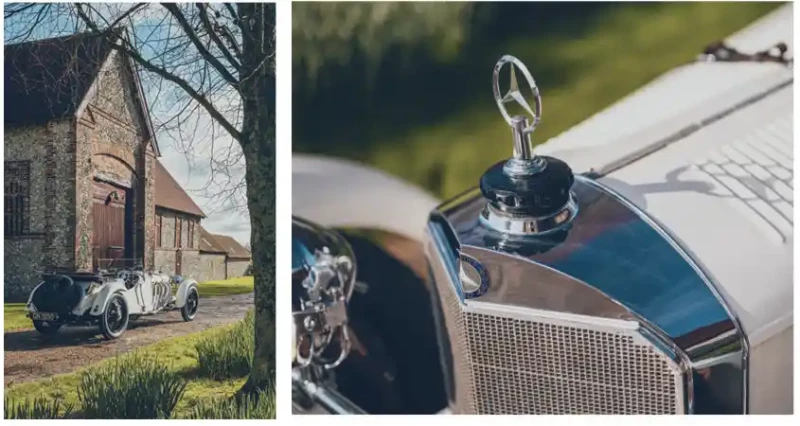
Above Supercharged 6.8-litre straight-six is, of course, beautifully engineered – and this car features a rare performance-enhancing 18-fin ‘Elephant’ blower.
Above Central gearchange was moved to right so that previous owner Peter Hampton, whose left arm was injured on D-Day 1944, could operate it.
Left, below and opposite Handsome Mercedes was originally built with long front wings, believed replaced in the 1940s. Other modifications followed.
‘Doing our best to dodge the springtime showers, we rolled out the almost centuryold Mercedes-Benz 36/220 and positioned it in the crisp sunlight. At this point, the beauty of the car did all the hard work – it was almost impossible to take a bad photo.’ Richard’s superb photography accompanies Mark Dixon’s feature.


